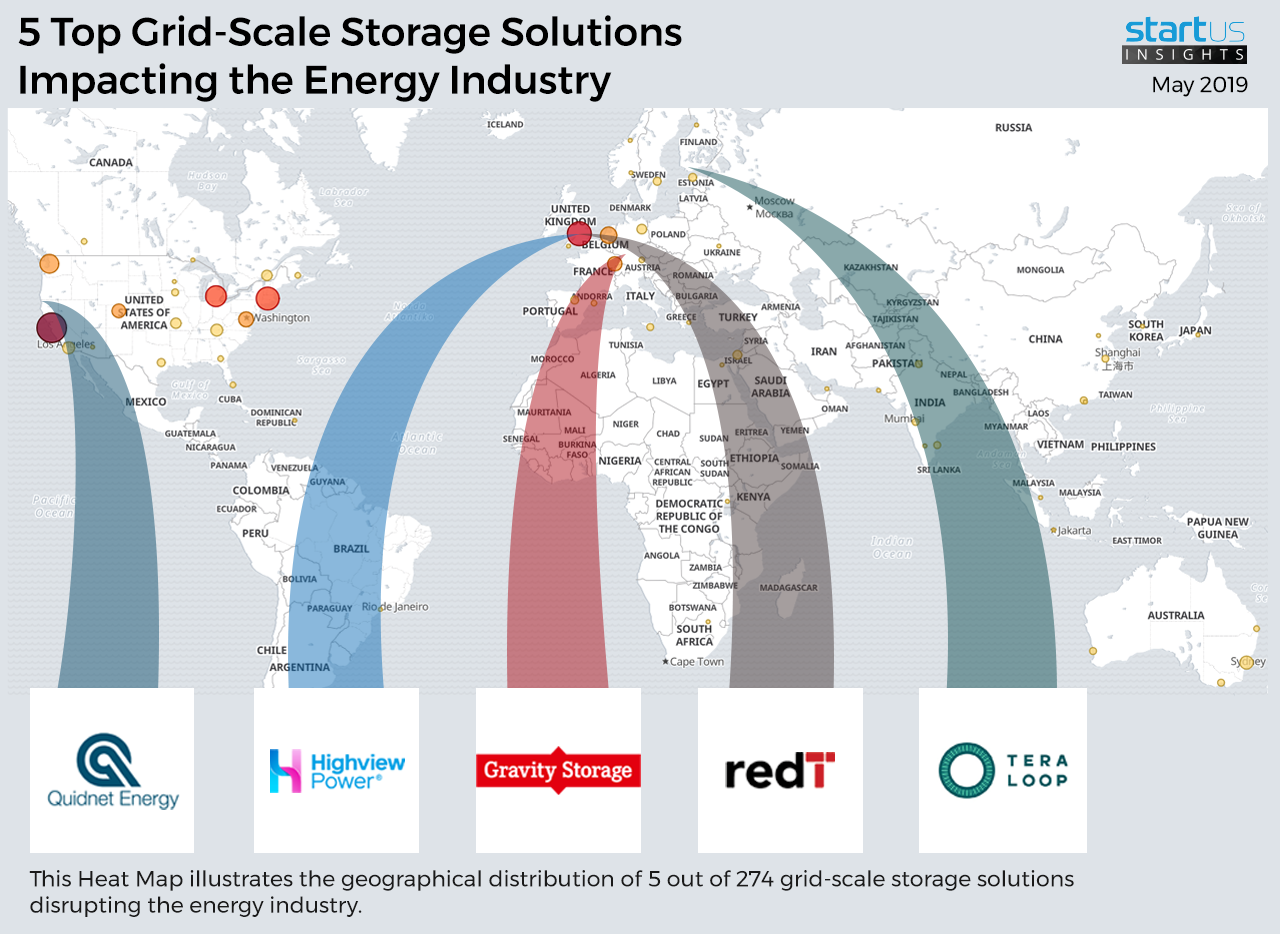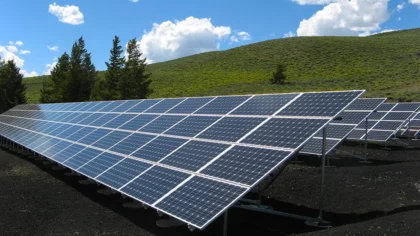Our Innovation Analysts recently looked into emerging technologies and up-and-coming startups in the energy industry. As there is a large number of startups working on a wide variety of solutions, we decided to share our insights with you. So, let’s take a look at promising grid-scale storage solutions.
Heat Map: 5 Top Grid-Scale Storage Startups
For our 5 picks of grid-scale storage startups, we used a data-driven startup scouting approach to identify the most relevant solutions globally. The Global Startup Heat Map below highlights 5 interesting examples out of 274 relevant solutions. Depending on your specific needs, your top picks might look entirely different.
RedT Energy – Vanadium Redox Flow Storage
Vanadium flow storage technology uses the flow of vanadium electrolyte across an ion exchange membrane. The advantages of this type of storage are safety, scalability and long-term operation. The vanadium electrolyte used in this battery is non-flammable and the battery operates at room temperature. UK-based RedT Energy provides utility companies with large-scale vanadium redox flow storage machines. These machines provide long-duration energy storage (over 4 hours), with subsecond response times and pulse discharge functionality. This allows for output up to 2x rated power for short periods of time. The batteries also have a long lifespan of over 25 years.
Heindl Energy – Gravity Storage
Gravity storage is based on the hydraulic lifting of a large rock mass. This technology enables the storage of large quantities of power for 6-14 hours, which can be reused later. During times of insufficient generation of renewable power, the water which is under high pressure from the rock mass is routed to a turbine, as in conventional hydroelectric plants, and generates electricity using a generator. Germany-based Heindl Energy develops gravity storage technology suitable for large-scale GWh-level applications. The use cases of this technology include the storage of excess power from PV plants during the day for discharging at night, and bulk storage to balance out fast-changing loads for utilities.
Teraloop – Kinetic Energy Storage
For this type of storage, electrical energy is converted to stored kinetic energy and then harvested as required. Kinetic energy storage is used as a short-term reserve for momentary grid frequency regulation balancing between electricity supply and consumption. The advantages of kinetic storage technology include faster response times, the ability to buy power at off-peak hours, and no carbon emissions. Finnish Teraloop develops a kinetic energy storage system that utilizes a range of electromagnetic technologies. The company uses magnetic levitation to increase the efficiency of energy storage, electromagnetic stabilization to achieve maximum rotating speed, and permanent magnet synchronous technology to maximize power-density of energy storage.
Highview Power – Liquid Air Energy Storage
Liquid Air Energy Storage technology is based on the principle of air liquefaction. This enables the easy storage of air as a liquid, providing high-density storages. When energy is needed, the liquid is converted back to gas which in turn generates energy that powers turbines and produces electricity. UK-based Highview Power targets the utility market and develops long-duration energy storage solutions to balance the grid and strengthen the power networks. This startup claims its liquid-air storages are available at sizes enough to store electricity for more than 200,000 homes for 12 hours. Besides that, this solution is cheaper than lithium-ion batteries and releases zero emissions.
Quidnet Energy – Underground Pumped Hydro Storage
Unlike the above-ground reservoirs, this new kind of hydro storage pumps water down into the earth to fill up the cracks in-between rocks that previously held fossil fuels. This is storing energy in the compression of the rocks. In order to discharge energy back to the grid, the pressurized water is released and acts as a spring as it races through a turbine-generator above ground, powering it to produce electricity. US-based Quidnet Energy develops a pumped hydro technology to enable widely deployable and cost-efficient alternatives to lithium-ion energy storages. The company’s solution is called Flex Formation Subsurface Pumped Hydro, it converts abandoned oil and gas wells into energy storage facilities for large-scale intermittent renewables integration.
What About The Other 269 Solutions?
While we believe data is key to creating insights it can be easy to be overwhelmed by it. Our ambition is to create a comprehensive overview and provide actionable innovation intelligence for your Proof of Concept (PoC), partnership, or investment targets. The 5 grid-scale storage startups showcased above are promising examples out of 274 we analyzed for this article. To identify the most relevant solutions based on your specific criteria and collaboration strategy, get in touch.









